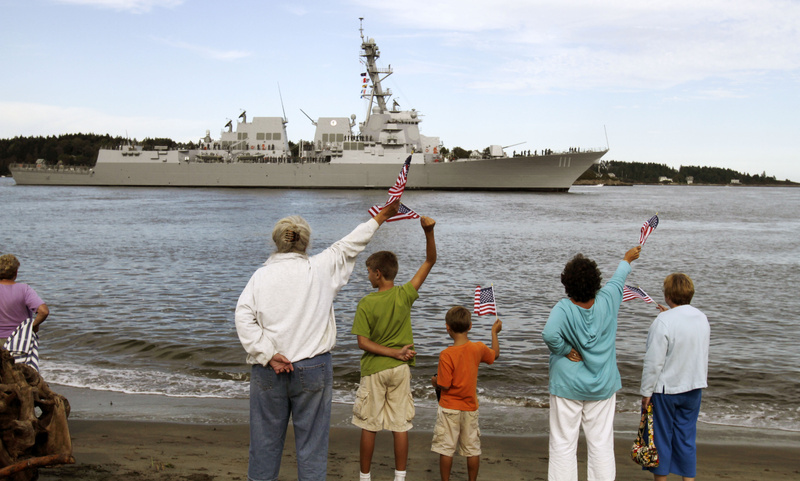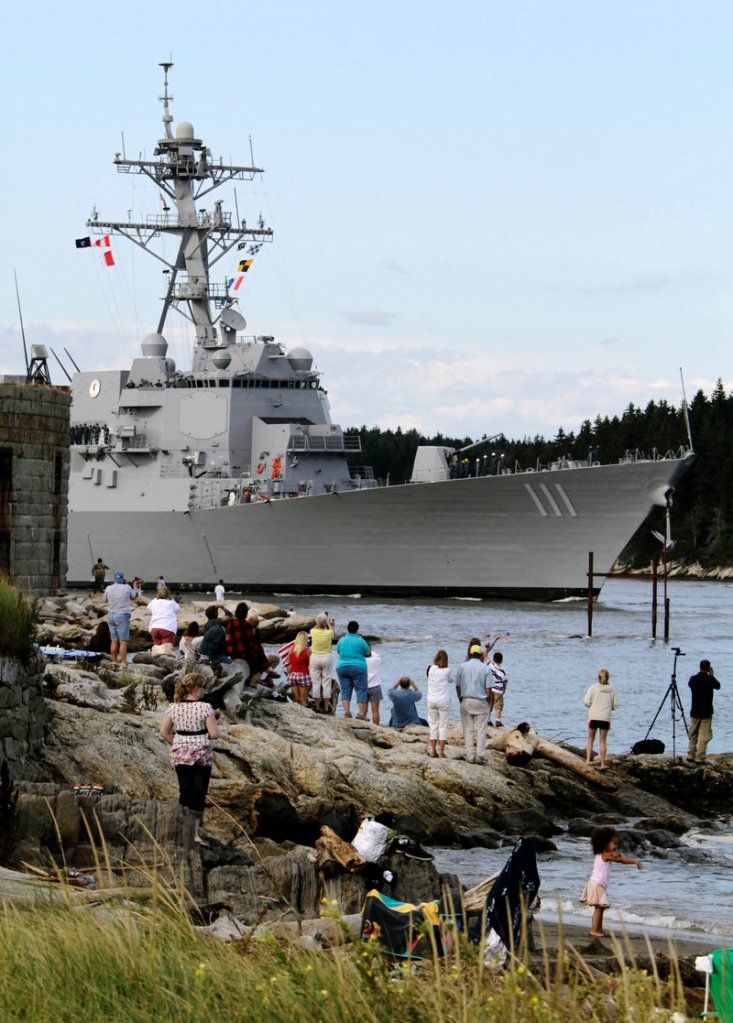Hundreds of people gathered on the banks of the Kennebec River on Thursday to bid farewell to a $1 billion Navy destroyer that was built at Bath Iron Works.
The USS Spruance’s departure for Key West, Fla., marked the end of a controversy in which the town of Phippsburg, commercial fishermen and others whose livelihoods depend on the Kennebec River challenged the federal government’s decision to dredge the river during the height of summer.
About 400 people gathered on the docks of the Maine Maritime Museum, just downriver from the shipyard, to watch the destroyer begin its voyage along the 13-mile stretch of river between Bath and the open ocean. The Bath Municipal Band played.
The museum fired off a water cannon when the ship sailed past, its crew members standing at attention.
Tom Bowler of Woolwich, a former BIW executive who is on the museum’s board of trustees, was invited to speak at the event.
“This was a day to celebrate a great accomplishment by Bath Iron Works,” Bowler said. “We’ve built ships for hundreds of years along the Kennebec, but this was probably the most complex and sophisticated ship that has ever been built.”
Jim DeMartini, spokesman for BIW, said the USS Spruance is the 33rd Arleigh Burke-class destroyer built for the Navy since the line of ships was introduced in 1985. The ship will be commissioned in Key West on Oct. 1 and its home port will be San Diego, Calif.
The Michael Murphy, DDG 112, is under construction in Bath and scheduled to be delivered to the Navy in the spring. Each destroyer costs about $1 billion, DeMartini said.
To clear the way for the Spruance, the U.S. Army Corps of Engineers hired Cashman Dredging and Marine Contracting Co. LLC of Quincy, Mass., to dredge 70,000 cubic yards of clean, sandy material from the river’s bottom, at a cost of $1.2 million.
Dredging is done about twice each decade to prevent Navy ships launched from BIW from running aground. It was last done in 2003.
The Navy informed the Army Corps in November 2010 that shallow bottoms in the Kennebec had hindered the transit of another Navy destroyer, forcing it to go outside the navigation channel.
The corps surveyed the river channel and concluded that the Spruance could not safely pass unless dredging was done. That forced the corps into an August dredging schedule.
BIW said a delayed launch of the Spruance could have a negative effect on future Navy contracts. It said the Navy has a right to expect that new vessels be able to navigate the river without encountering hazards.
But commercial fishermen, recreational boaters, clam diggers and Phippsburg officials objected, suing in U.S. District Court for a preliminary injunction to halt the project.
They argued that dredging sections of the 13-mile river channel between Bath and the mouth of the Kennebec in the height of summer would disrupt lobster fishing, close clam flats and interfere with recreational boating. Judge John Woodcock Jr. dismissed their lawsuit on July 29.
Woodcock ruled that while the public has a significant interest in making sure dredging minimizes environmental and economic harm, it also has a strong interest in national defense and the “continued economic vitality of BIW.”
The dredging began Aug. 1 and ended Aug. 14, several days ahead of schedule, said Tim Dugan, a spokesman for the Army Corps. “As far as I know, the work went pretty well,” he said.
The Maine Department of Environmental Protection, which came under fire after it issued the corps a dredging permit, also kept an eye on the project.
Samantha DePoy-Warren, spokeswoman for the DEP, said that despite opponents’ concerns, there was no documented taking of endangered fish such as salmon or sturgeon, no clam flats had to be closed, and no elevated levels of bacteria were documented at the disposal site near Doubling Point.
The second disposal site, Jackknife Ledge, is off Popham Beach.
Though the DEP would have preferred that the dredging occur in the off-season, DePoy-Warren said it appears that science backed up the agency staff’s decision.
“This department deals in science and not in speculation,” she said. “Our staff would never have issued this permit if they didn’t believe in the science.”
Though Steve Hinchman doesn’t totally disagree with DePoy-Warren’s assessment, he said the state and federal governments have turned a blind eye to the project’s long-term impact on the river.
Hinchman, a lawyer based in West Bath, filed the motion for a preliminary injunction against the Army Corps.
“It’s cherry-picking the good news,” he said in response to the DEP’s statement.
Hinchman said about 20 lobster boats from surrounding towns cannot fish near Jackknife Ledge.
“They buried that area under several meters of sand,” he said. “It was definitely a job killer.”
He also said dredging makes it nearly impossible to see “pieces of shredded fish.”
“There is no way to know what they are sucking up,” he said, referring to endangered fish species that might have been harmed in the dredging operation.
Staff Writer Dennis Hoey can be contacted at 791-6365 or at:
dhoey@pressherald.com
Send questions/comments to the editors.





Success. Please wait for the page to reload. If the page does not reload within 5 seconds, please refresh the page.
Enter your email and password to access comments.
Hi, to comment on stories you must . This profile is in addition to your subscription and website login.
Already have a commenting profile? .
Invalid username/password.
Please check your email to confirm and complete your registration.
Only subscribers are eligible to post comments. Please subscribe or login first for digital access. Here’s why.
Use the form below to reset your password. When you've submitted your account email, we will send an email with a reset code.